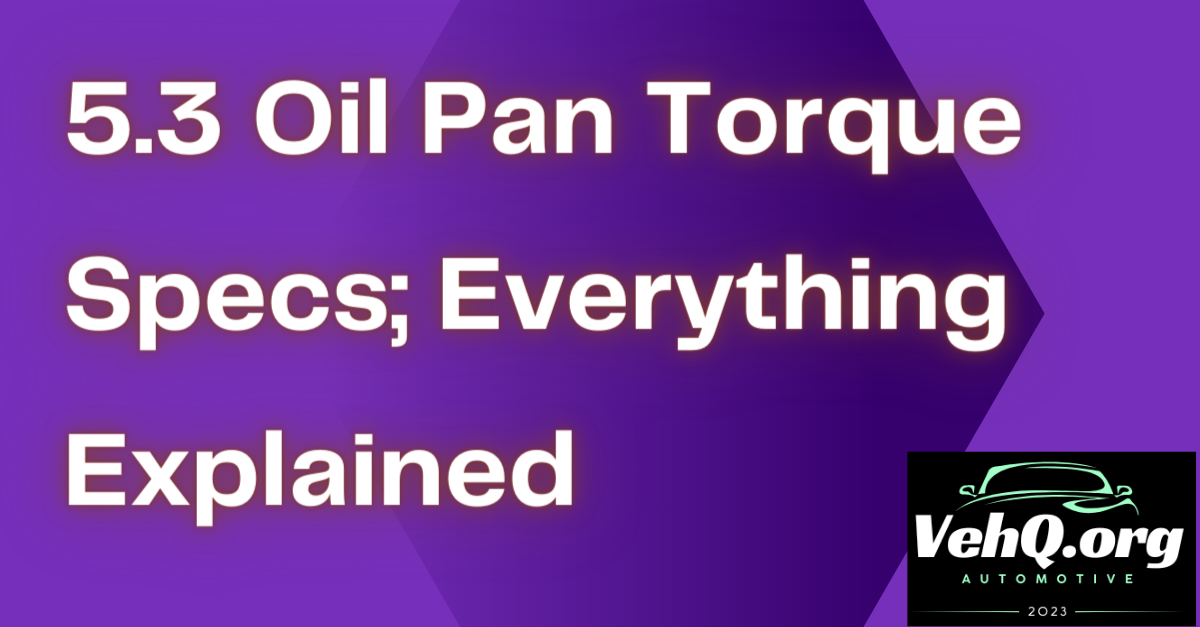When working on a 5.3-liter engine, understanding and correctly applying oil pan torque specifications is crucial. Proper torque ensures a secure seal, prevents leaks, and maintains engine integrity.
This article provides a detailed look at the oil pan torque specs for the 5.3 engine, including the importance of torque specifications, step-by-step tightening instructions, common mistakes to avoid, and variations in specs for different models.
What is 5.3 oil pan torque, and why is it important?

The 5.3 oil pan torque refers to the specific torque values required to tighten the bolts that secure the oil pan to the engine block in a 5.3-liter engine. Torque is a measure of the rotational force applied to the bolts, typically specified in foot-pounds (ft-lbs) or inch-pounds (in-lbs). For a 5.3-liter engine, typical torque values are:
- Rear bolts: 106 in-lbs
- Front cover bolts: 18 ft-lbs
- Bolts into the iron block: 37 ft-lbs
These values can vary slightly depending on the specific model and year of the engine.
Why is Proper Torque Important?
1. Prevents Leaks
Properly torquing the oil pan bolts ensures that the oil pan gasket is compressed evenly, creating a tight seal between the oil pan and the engine block. This prevents oil leaks, which can lead to engine damage if not addressed.
2. Avoids Damage
Over-tightening the bolts can strip the threads or warp the oil pan, while under-tightening can cause bolts to loosen over time due to engine vibrations. Both scenarios can lead to significant engine damage.
3. Ensures Durability and Performance
Correct torque application helps maintain the structural integrity of the engine. Ensuring that all components are securely fastened without being overly stressed prolongs the engine’s life and maintains its performance.
4. Maintains Proper Functioning
Applying the correct torque values ensures that the oil pan remains in place, which is crucial for proper oil circulation and lubrication of engine components. This is vital for the engine’s smooth operation and overall health.
Importance of Correct Torque Specifications
Applying the correct torque to the oil pan bolts is essential for several reasons:
Preventing Leaks – Proper torque ensures that the gasket seals correctly, preventing oil leaks that could lead to engine damage.
Avoiding Damage – Over-tightening can strip threads or warp the oil pan, while under-tightening may cause bolts to loosen over time.
Ensuring Durability – Correct torque helps maintain the engine’s integrity and longevity by ensuring all components are securely fastened.
Variations in Torque Specs for Different Models

Here is a detailed table highlighting the variations in torque specs for different 5.3 engine models. The table includes the year, model, specific torque values for various bolts, and additional notes for each model.
| Year | Model | Bolt Type | Torque Specification | Additional Notes |
|---|---|---|---|---|
| 2000 | GM 5.3 | Transmission Bolts (M10) | 33 ft-lbs (45 Nm) | Ensure surfaces are clean and level with the front cover oil pan. |
| Engine Block to Oil Pan (M7) | 11 ft-lbs (15 Nm) | |||
| Oil Pan Guard on Engine Block | 27 ft-lbs (37 Nm) | |||
| 2005 | GM 5.3 | General Bolts | 14-18 ft-lbs | Specific torque may vary slightly; consult manual. |
| 2012 | GM 5.3 | Oil Pump Bolts | 18 ft-lbs | Use sealant as specified by manufacturer. |
| Oil Pickup Tube (Step 1) | 106 in-lbs | |||
| Oil Pickup Tube (Step 2) | 18 ft-lbs | |||
| Timing Cover Bolts | 18 ft-lbs | |||
| Camshaft Position Sensor | 89 in-lbs | |||
| Front Cover | 18 ft-lbs | |||
| Rear Cover | 106 in-lbs | |||
| Oil Pan to Transmission | 37 ft-lbs | |||
| 2013 | GM 5.3 | Inner Bolts | 15 ft-lbs + 80° | Tighten to specified torque, then turn 80°. |
| Outer Bolts | 15 ft-lbs + 53° | Tighten to specified torque, then turn 53° | ||
| Side Bolts | 18 ft-lbs | |||
| 2002 | Chevy 5.3 | Oil Pan Bolts | 106 in-lbs | Hand-tighten initially to avoid cross-threading. |
| Front Cover Bolts | 18 ft-lbs | |||
| 6.0 IS | Oil Pan to Block | 18 ft-lbs | Ensure even tightening in a criss-cross pattern. |
Additional Notes
- General Guidelines: Always start tightening bolts from the center and work your way outward to ensure even pressure distribution.
- Sealant Use: Depending on the gasket type, a sealant might be necessary at certain transition points to ensure a proper seal.
- Tools: A calibrated torque wrench is essential for applying precise torque values to prevent over-tightening or under-tightening bolts.
- Manufacturer’s Guidelines: For the most accurate and specific torque values, always refer to the engine manual or manufacturer’s guidelines.
By following the detailed torque specifications for your specific model, you can ensure a secure and leak-free installation of the oil pan, which is crucial for the proper functioning and longevity of your engine.
Steps to Properly Torque the Oil Pan Bolts (LS Oil Pan Torque Sequence)
Tools and Preparation
Before beginning, gather the necessary tools:
- Torque wrench
- Ratchet and sockets
- New gasket (if replacing the old one)
- Sealant (if specified by the gasket manufacturer)
Initial Positioning
- Align the Oil Pan: Place the oil pan against the engine block, ensuring all bolt holes are aligned.
- Hand-Tighten Bolts: Insert all bolts by hand to avoid cross-threading.
First Pass: Initial Tightening
- Tighten the bolts lightly in a criss-cross pattern starting from the center and moving outward. This initial pass ensures the pan is seated evenly against the block.
Second Pass: Half Torque Tightening
- Use a torque wrench to tighten each bolt to half of the recommended torque value, typically around 9 ft-lbs (12 Nm) for most LS engines.
Final Pass: Full Torque Tightening
- Complete the tightening process by applying the full torque value. For most 5.3 engines, the specs are:
- Rear bolts: 106 in-lbs
- Front cover bolts: 18 ft-lbs
- Bolts into the iron block: 37 ft-lbs.
Common Mistakes to Avoid
- Skipping Torque Sequence: Always follow the recommended tightening sequence to ensure even pressure distribution.
- Over-Tightening: Exceeding the specified torque can strip threads or warp the oil pan.
- Under-Tightening: Insufficient torque can cause bolts to loosen and lead to leaks.
- Using Incorrect Tools: A calibrated torque wrench is essential for applying precise torque values.
Impact of Oil Pan Material on Torque Specs
The material of the oil pan can influence torque specifications. For example, aluminum oil pans may require different torque settings compared to steel pans due to their material properties. Always consult the manufacturer’s guidelines for the correct specifications based on the oil pan material.
FAQs
1. What type of gasket should be used with the oil pan on a 5.3-liter engine?
Answer: The type of gasket used can affect the torque specifications and the overall sealing effectiveness. For a 5.3-liter engine, it’s recommended to use a high-quality rubber or silicone gasket designed for your specific engine model.
Some gaskets might also require a small amount of RTV sealant at certain points to ensure a complete seal. Always consult the manufacturer’s guidelines for the best gasket type.
2. Do I need to use sealant with the oil pan gasket?
Answer: While many modern gaskets are designed to seal without additional sealant, applying a thin layer of RTV silicone sealant at the corners and where the front and rear covers meet the oil pan can help ensure a better seal. This is especially useful for older engines or where the mating surfaces may not be perfectly flat .
3. Can I reuse the oil pan bolts, or should they be replaced?
Answer: It is generally recommended to replace the oil pan bolts when reinstalling the oil pan, especially if they are torque-to-yield bolts.
Torque-to-yield bolts stretch when torqued and can lose their effectiveness if reused. Always check the manufacturer’s specifications to determine if new bolts are required.
4. What should I do if the oil pan bolts keep loosening over time?
Answer: If the oil pan bolts are loosening, it could be due to improper torque application or issues with the gasket. Ensure that you are using a calibrated torque wrench and following the correct torque sequence.
Additionally, using a thread locker on the bolts can help prevent them from loosening due to vibrations.
5. How do I know if my torque wrench is properly calibrated?
Answer: Regular calibration of your torque wrench is essential for accurate torque application. Most torque wrench manufacturers recommend calibration every 5,000 cycles or once a year, whichever comes first.
Calibration should be done by a professional service to ensure accuracy. You can also periodically check the calibration against a known standard or another calibrated torque wrench.
Conclusion
Applying the correct torque specifications for a 5.3 oil pan is crucial for maintaining engine performance and longevity. By following the step-by-step guide, avoiding common mistakes, and considering variations for different models, you can ensure a secure and leak-free installation. Always refer to the engine manual or manufacturer’s guidelines for the most accurate and specific torque values.



